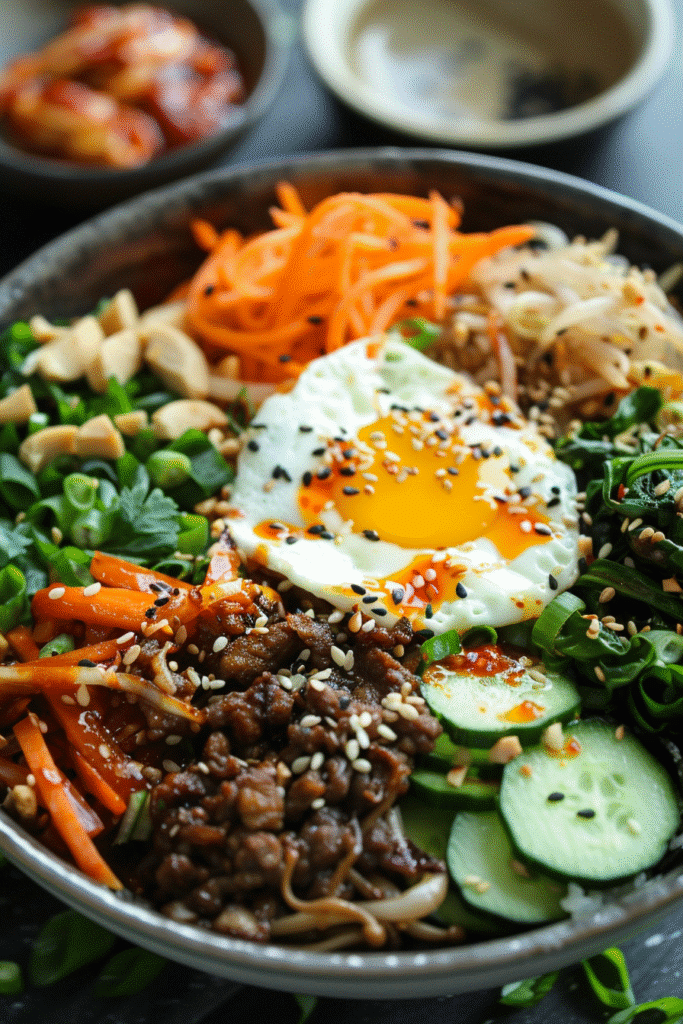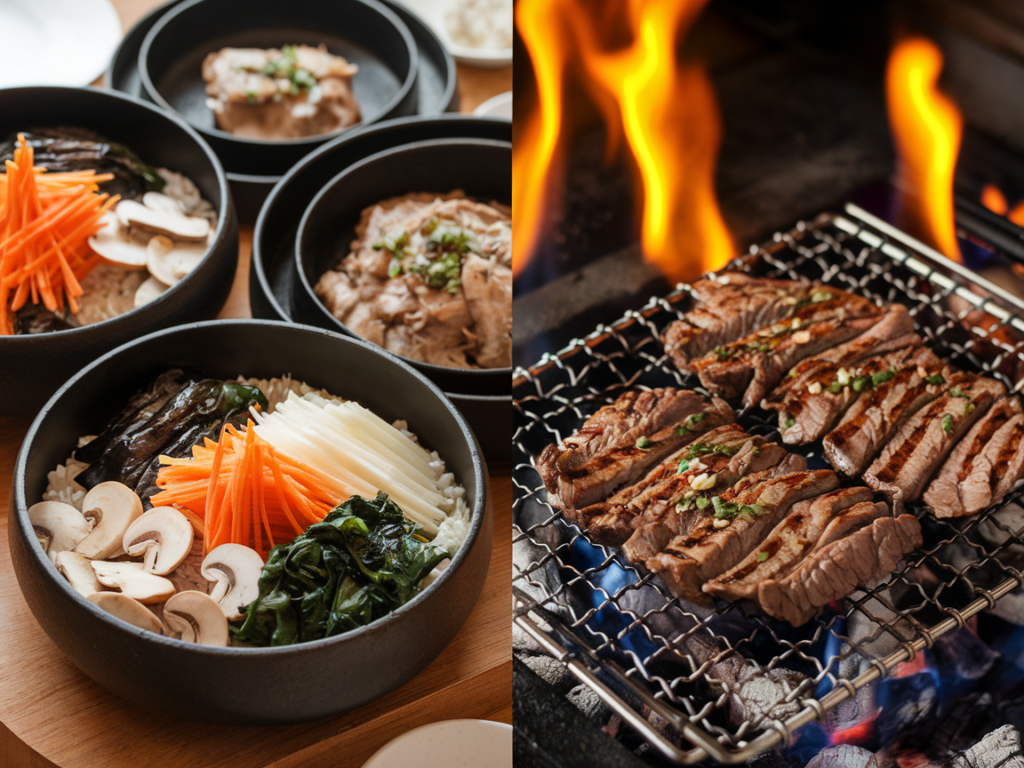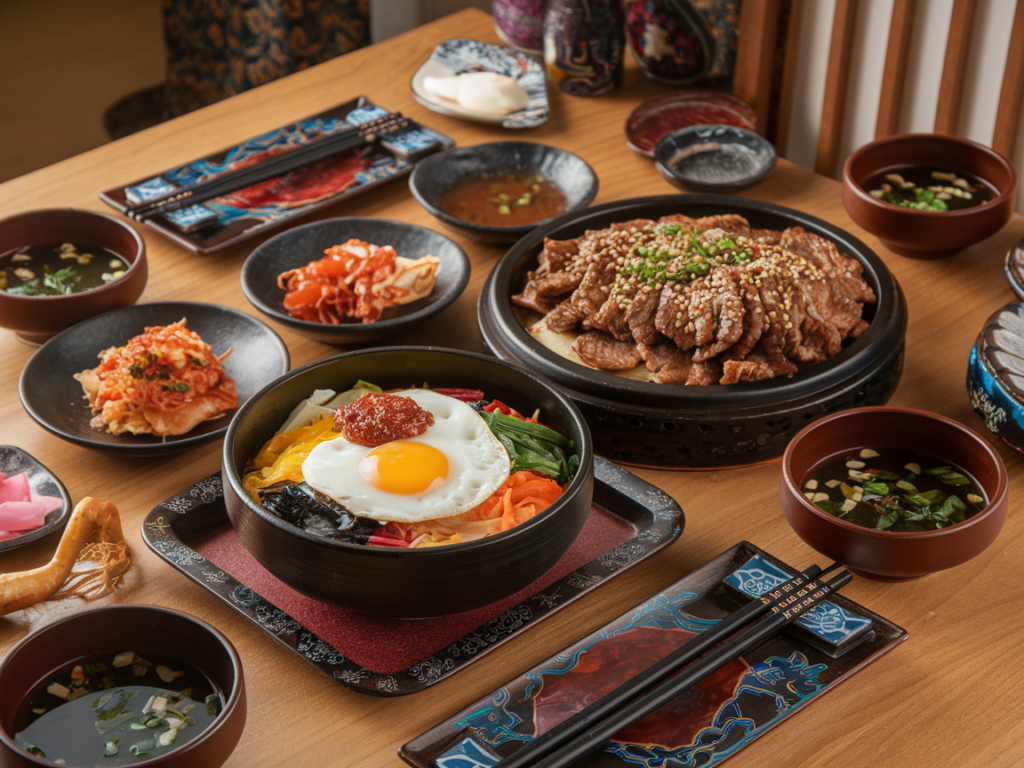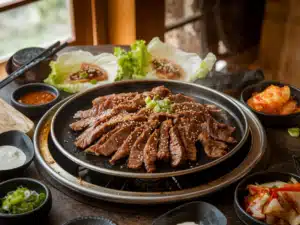
Bibimbap vs Bulgogi: Speedy Korean Favorites Demystified (Grandma-Approved Shortcuts!)
🥢 “Fast Flavors, Family Memories because global cuisine should be fun, not fussy!” – Emma, Spedy Recipes
Table of Contents
Why Compare Bibimbap & Bulgogi? Grandma’s “East Meets Dam” Wisdom
Growing up near the water dam, my grandma had a rule: “Every culture’s comfort food deserves a seat at our table but let’s make it quick!” That’s why I’m breaking down bibimbap (Korea’s vibrant rice bowl) and bulgogi (sweet-savory grilled meat) with Spedy Recipes’ signature twist. Both dishes are beloved worldwide, but busy families often confuse them. Let’s clear the air with time-saving hacks, kid-friendly swaps, and a dash of Grandma’s storytelling!
Bibimbap vs Bulgogi: The Speedy Breakdown
1. Bibimbap: The “Everything but the Kitchen Sink” Bowl
- What It Is: A colorful mix of rice, veggies, protein, egg, and gochujang (chili paste), all stirred together.
- Grandma’s Take: “Like my leftover casseroles but prettier!”
- Spedy Twist: Use microwavable rice, pre-chopped veggies, and rotisserie chicken for a 20-minute version.
2. Bulgogi: The “Sweet-Savory Grill Master”
- What It Is: Thinly sliced beef (or pork) marinated in soy sauce, sugar, garlic, and sesame oil, then grilled.
- Grandma’s Take: “Korean BBQ meets our dam-side cookouts!”
- Spedy Twist: Opt for ground beef + 10-minute marinade (no slicing required!).
Speedy Ingredient Guide: No Fancy Shopping Required!
Bibimbap Essentials (30-Minute Version)
- Rice: Leftover or microwavable jasmine rice.
- Protein: Ground beef, tofu, or canned chickpeas.
- Veggies: Pre-shredded carrots, bagged spinach, frozen corn.
- Sauce: Gochujang + soy sauce + honey (mix in 2 mins!).
Bulgogi Essentials (20-Minute Version)
- Protein: Ground beef (no slicing!) or pre-sliced “stir-fry beef.”
- Marinade: Soy sauce + brown sugar + grated apple (for tenderizing!).
- Add-Ons: Instant rice + microwave steamed broccoli.

Side-by-Side Comparison: Tradition vs Spedy Hacks
| Aspect | Bibimbap | Bulgogi |
|---|---|---|
| Prep Time | 30 mins (with shortcuts!) | 20 mins (ground beef hack!) |
| Key Flavor | Spicy, tangy, crunchy | Sweet, savory, smoky |
| Kid Appeal | DIY toppings = edible art project | “Korean tacos” with lettuce wraps |
| Leftover Magic | Turn into fried rice | Stuff into quesadillas or omelets |
5 Spedy Tips to Master Both Dishes
- Marinate in a Flash: For bulgogi, massage ground beef with sauce while preheating the pan.
- Veggie Shortcuts: Buy pre-sliced mushrooms or frozen stir-fry mixes for bibimbap.
- Sauce Hacks: Mix gochujang with mayo for a mild bibimbap drizzle kids love.
- Freezer-Friendly: Batch-cook bulgogi meat and freeze for “emergency Korean nights.”
- Bloopers Welcome: Overcooked rice? Turn it into crispy bibimbap patties!
Family-Friendly Recipes: 30-Minute Bibimbap & 20-Minute Bulgogi
Speedy Bibimbap Bowls
Ingredients (Serves 4):
- 2 cups microwavable rice
- 1 lb ground beef
- 1 bag spinach (sautéed with garlic)
- 1 cup pre-shredded carrots
- 4 fried eggs
- Sauce: 3 tbsp gochujang + 1 tbsp honey
Steps:
- Cook beef in a skillet (5 mins!).
- Microwave rice and veggies (8 mins!).
- Layer rice ➔ beef ➔ veggies ➔ egg. Drizzle sauce and mix!
Speedy Bulgogi “Tacos”
Ingredients (Serves 4):
- 1 lb ground beef
- Marinade: ¼ cup soy sauce + 2 tbsp brown sugar + 1 tbsp grated apple
- Lettuce leaves or tortillas
- Toppings: Quick-pickled cucumbers (5 mins with vinegar + sugar!)
Steps:
- Marinate beef while heating the skillet (5 mins!).
- Cook beef until caramelized (10 mins!).
- Serve in lettuce cups with pickles.
Speedy Bulgogi Tacos
Equipment
- Skillet
Ingredients
Beef and Marinade
- 1 lb ground beef
- 1/4 cup soy sauce
- 2 tbsp brown sugar
- 1 tbsp grated apple for tenderizing
To Serve
- lettuce leaves or tortillas
- quick-pickled cucumbers 5 mins in vinegar + sugar
Instructions
- Marinate ground beef with soy sauce, brown sugar, and grated apple while preheating the skillet (about 5 minutes).
- Cook beef in a skillet until browned and caramelized (about 10 minutes).
- Serve in lettuce leaves or tortillas, topped with quick-pickled cucumbers.
Notes
FAQs: Bibimbap & Bulgogi Made Simple
Can I make these gluten-free?
Yes! Use tamari instead of soy sauce and check gochujang labels.
My kid hates spicy food. Help!
Skip gochujang for bibimbap use teriyaki sauce instead. For bulgogi, reduce sugar for a savory twist.
Can I use chicken instead of beef?
Absolutely! Ground chicken works for both dishes.
Are these freezer-friendly?
Yes! Freeze cooked bulgogi meat or bibimbap components for up to 3 months.
For more culinary adventures, try this Pickle Pie Pizza Recipe, which pushes the boundaries of traditional cooking.
Why These Dishes Fit the Spedy Family
- Tradition Reinvented: Swap hours of marinating for quick, flavorful hacks.
- Joyful Accessibility: Let kids build their own bowls or tacos messy hands = happy hearts!
- Creativity & Play: Turn bibimbap into “rainbow layers” or bulgogi into DIY lettuce wraps.
Cooking With Kids: Global Flavors, Tiny Chefs
- Bibimbap Art: Let kids arrange veggies into smiley faces or “flower” patterns.
- Bulgogi Tacos: Host a “build-your-own” taco night with colorful toppings.
- Story Time: Share how Grandma once mistook gochujang for jam (“Spicy pancakes? Why not!”).

Final Bite
Whether you’re team bibimbap or bulgogi, both dishes prove that global flavors can be speedy, playful, and deeply nourishing. As Grandma always said: “Good food is a language everyone understands no passport required!”
Love colorful, crave-worthy bowls? Follow me on Pinterest for more easy and delicious recipes like this bibimbap! 🍚✨

